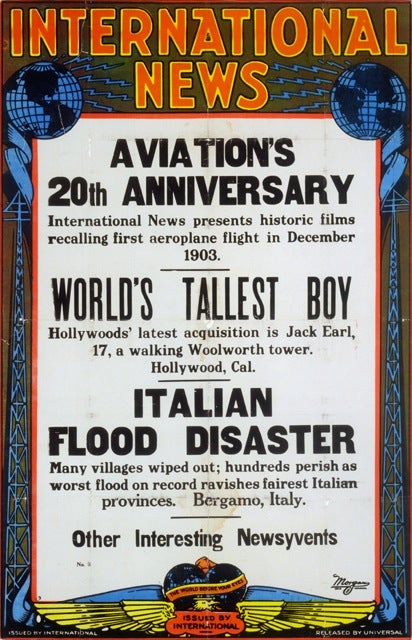“HOLLYWOOD PRESENTS THE WORLD’S TALLEST BOY: A Veritable Walking Woolworth Tower”

So read the 1923 poster that introduced my 16-year-old, seven-and-a-half-foot uncle, Jake Erlich (née Jack Earle), to silent film audiences around the world. For a time, Jake would be known as “the tallest man in the world,” eventually reaching an astounding eight-and-a-half-feet in height.
He would go on to make 49 films at Century Studios, starring with such top-billed talent of the era as child star Baby Peggy (Diana Serra Cary) and working with director Fred Fishbach, one of the only Hollywood personalities to defend Fatty Arbuckle during his notorious trial.
My new book, "The Long Shadows," is the story of Jake’s remarkable life.
Born in 1906 in El Paso, Tex., Jake was a normal boy until age seven, when he suddenly began to grow with astonishing speed. His mother lamented to a friend that her son appeared to grow an inch every night. Soon, his worried father was forced to buy Jake a new pair of shoes every two weeks until he wore the largest shoes in town.
After that, all of Jake’s shoes and clothes would have to be custom-made to fit his enormous frame. His frantic parents took him from doctor to doctor, but none of them could explain the cause of his rapid growth or offer any treatment.
Inevitably, Jake’s extraordinary height brought him unwelcome attention from his classmates, who cruelly taunted and teased him. Some went so far as to throw rocks at him.

A sensitive boy, Jake became increasingly withdrawn and solitary in his habits, taking back alleys and avoiding contact with others. When he was 16, my grandfather took him to Santa Monica for a change of scenery and a hoped-for change in spirit. It was on that fateful fishing trip that Jake was discovered by talent scouts for Century Comedies.
I often imagine how this depressed, shy giant of a teenager — who craved nothing more than anonymity — must have felt when he was suddenly thrust in front of kleig lights and forced into the hustle and bustle of the Grand Parade that was early Hollywood. Yet demonstrating the resilience that he would demonstrate throughout his life, Jake rose to the occasion, relishing his roles, making friends, and earning recognition for his on-screen performances.
He also began to explore his lifelong interest in photography and writing. This was the beginning of a profound transition to a new life that would bring Jake worldwide fame and a new sense of personal worth and self-confidence.
Then an unexpected trauma changed his life forever. While filming a stunt during his 49th film, Jake fell 14 feet from a speeding “funny car” and crashed into the asphalt, where a chunk of wood attached to the camera boom broke off and smashed him in the back of the head. He awoke in the hospital with a fractured nose and blurred vision.
At first, the doctors attributed this to “kleig eyes,” or “a sunburn of the eyeball,” a common malady for actors of the day. However, three days later, Jake went blind.
His doctors were stumped. For months, Jake would remain sightless. Finally, his blindness was traced to a brain tumor pressing on his optic nerve. Later, doctors would learn that this same tumor was the cause of his phenomenal growth. After an experimental course of X-ray therapy, Jake’s tumor shrank, his vision returned and he finally stopped growing. The accident had saved his sight and his life.

While Jake was recuperating in El Paso, Ringling Bros. and Barnum & Bailey Circus came to town. He reluctantly agreed to accompany his friends to the show. When he stepped into the sideshow tent, however, one of the most embarrassing moments in the annals of circus history occurred. Jake was a foot taller than the professional giant!
The very next day, an agent from the circus arrived at Jake’s door to offer him a contract. Thus began a 14-year career traveling the world as a sideshow performer with Ringling Brothers, where he would make some of his closest friends. Among them were Harry and Daisy Doll, “little people” who appeared as Munchkins in "The Wizard of Oz" and starred in Todd Browning’s classic film "Freaks."
After his movie and circus careers, Jake would become a renowned painter, published poet and an award-winning photographer. Several of his paintings are currently on exhibit at the El Paso Museum of Art and one of his sculptures can be found in the permanent collection at the Museum of Natural History in New York.
Remarkably, Jake was also a successful vaudeville performer, musician, dancer, an expert marksman and a successful businessman.
"The Long Shadows" is set between 1906 and 1940, a tumultuous time in both U.S. and world history. It tells the universal story of the struggle to overcome adversity, the profound power of self-acceptance, the danger of stereotypes and the healing that comes from self-expression through the creative arts.
In the words of film historian, author, and former child star Baby Peggy, “Six decades later, I am astounded to learn the miraculous ways Jake changed his fate. He was a uniquely courageous soul who proved to be a giant in more ways than one.”